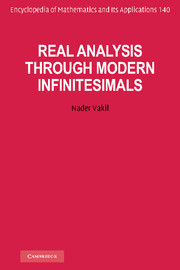Book contents
- Frontmatter
- Contents
- Preface
- Introduction
- PART I ELEMENTS OF REAL ANALYSIS
- 1 Internal set theory
- 2 The real number system
- 3 Sequences and series
- 4 The topology of ℝ
- 5 Limits and continuity
- 6 Differentiation
- 7 Integration
- 8 Sequences and series of functions
- 9 Infinite series
- PART II ELEMENTS OF ABSTRACT ANALYSIS
- Appendix A Vector spaces
- Appendix B The b-adic representation of numbers
- Appendix C Finite, denumerable, and uncountable sets
- Appendix D The syntax of mathematical languages
- References
- Index
6 - Differentiation
from PART I - ELEMENTS OF REAL ANALYSIS
Published online by Cambridge University Press: 05 January 2013
- Frontmatter
- Contents
- Preface
- Introduction
- PART I ELEMENTS OF REAL ANALYSIS
- 1 Internal set theory
- 2 The real number system
- 3 Sequences and series
- 4 The topology of ℝ
- 5 Limits and continuity
- 6 Differentiation
- 7 Integration
- 8 Sequences and series of functions
- 9 Infinite series
- PART II ELEMENTS OF ABSTRACT ANALYSIS
- Appendix A Vector spaces
- Appendix B The b-adic representation of numbers
- Appendix C Finite, denumerable, and uncountable sets
- Appendix D The syntax of mathematical languages
- References
- Index
Summary
Consider a “smooth curve” on the plane such as a circle or a parabola. Intuitively, we think of such curves as smooth because they have a tangent line at each point and because the slopes of these tangent lines vary continuously as the point of tangency moves along the curve. The concept of the derivative enables us to discuss such geometric phenomena analytically. Thus, for example, we refer to the graph of a function f : (a, b) → ℝ as a smooth curve when f has a continuous derivative on (a, b). The reader will be familiar with such applications of the notion of the derivative. In particular, we assume that the reader knows how to calculate the derivatives of trigonometric functions as well as how to use derivatives to sketch graphs and compute maxima and minima. More sophisticated applications of derivatives involve complex interactions of differentiation (the operation of taking the derivative of a function) with other mathematical operations (e.g., infinite summation and integration). For this, it is essential that we have a precise understanding of the definition of the derivative and that we develop the skills necessary for investigating the theoretical properties of differentiable functions. This is the goal of the present chapter.
- Type
- Chapter
- Information
- Real Analysis through Modern Infinitesimals , pp. 187 - 230Publisher: Cambridge University PressPrint publication year: 2011



